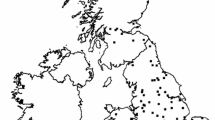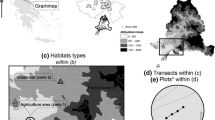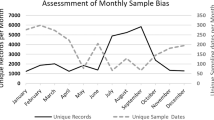Abstract
Different taxonomic groups perceive and respond to the environment at different scales. We examined the effects of spatial scale on diversity patterns of butterflies and birds in the central Great Basin of the western USA. We partitioned the landscape into three hierarchical spatial levels: mountain ranges, canyons, and sites within can yons. We evaluated the relative contribution of each level to species richness and quantified changes in species composition at each level. Using additive partitioning, we calculated the contribution of spatial level to overall species diversity. Both canyon and mountain range had significant effects on landscape-level species richness of butterflies and birds. Species composition of butterflies was more similar in space than species composition of birds, but assemblages of both groups that were closer together in space were less similar than assemblages that were further apart. These results likely reflect differences in resource specificity and the distribution of resources for each group. Additive partitioning showed that alpha diversity within canyon segments was the dominant component of overall species richness of butterflies but not of birds. As the size of a sampling unit increased, its contribution to overall species richness of birds increased monotonically, but the relationship between spatial scale and species richness of butterflies was not linear. Our work emphasizes that the most appropriate scales for studying and conserving different taxonomic groups are not the same. The ability of butterflies and birds to serve as surrogate measures of each other’s diversity appears to be scale-dependent.
Similar content being viewed by others
References
Addicott J.F., Aho J.M., Antolin M.F., Padilla D.K., Richardson J.S. and Soluk D.A. 1987. Ecological neighborhoods: scaling environmental patterns. Oikos 49: 340–346.
Allan J.D. 1975. Components of diversity. Oecologia 18: 359–367.
Allen T.F.H. and Starr T.B. 1982. Hierarchy: Perspectives for Ecological Complexity. University of Chicago Press, Chicago, Illinois, USA.
American Ornithologists’ Union (AOU). 1992. Birds of North America. AOU, Washington, D.C., USA.
Anderson M.J. 2001. A new method for non-parametric multivariate analysis of variance. Austral Ecology 26: 32–46.
Austin G.T. and Murphy D.D. 1987. Zoogeography of Great Basin butterflies: patterns of distribution and differentiation. Great Basin Naturalist 47: 186–201.
Behle W.H. 1978. Avian biogeography of the Great Basin and intermountain region. Great Basin Naturalist Memoirs 2: 55–80.
Belthoff J.R., Powers L.R. and Reynolds T.D. 1998. Breeding birds at the Idaho National Engineering and Environmental Laboratory, 1985-1991. Great Basin Naturalist 58: 167–183.
Bibby C.J., Burgess N.D., Hill D.A. and Mustoe S. 2000. Bird Census Techniques. Academic Press, London, UK.
Brown J. 1978. The theory of insular biogeography and the distribution of boreal mammals and birds. Great Basin Naturalist Memoirs 2: 209–228.
DeVries P.J., Murray D. and Lande R. 1997. Species diversity in vertical, horizontal, and temporal dimensions of a fruit-feeding butterfly community in an Ecuadorian rainforest. Biological Journal of the Linnean Society 62: 343–364.
Dobkin D.S. and Rich A.C. 1998. Comparison of line-transect, spot-map, and point-count surveys for birds in riparian areas of the Great Basin. Journal of Field Ornithology 69: 430–443.
Droege S., Cyr A. and Larivée J. 1998. Checklists: an under-used tool for the inventory and monitoring of plants and animals. Conservation Biology 12: 1134–1138.
Fleishman E. and MacNally R. 2002. Topographic determinants of faunal nestedness in Great Basin butterfly assemblages. Conservation Biology 16: 422–429
Fleishman E. and Murphy D.D. 1999. Patterns and processes of nestedness in a Great Basin butterfly community. Oecologia 119: 133–139.
Fleishman E., Austin G.T. and Murphy D.D. 1997. Natural history and biogeography of the butterflies of the Toiyabe Range, Nevada (Lepidoptera: Papilionoidea). Holarctic Lepidoptera 4: 1–18.
Fleishman E., Austin G.T. and Weiss A.D. 1998. An empirical test of Rapoport’s rule: elevational gradients in montane butterfly communities. Ecology 79: 2482–2493.
Fleishman E., Murphy D.D. and Austin G.T. 1999. Butterflies of the Toquima Range, Nevada: distribution, natural history, and comparison to the Toiyabe Range. Great Basin Naturalist 59: 50–62.
Fleishman E., Fay J.P. and Murphy D.D. 2000. Upsides and down-sides: contrasting topographic gradients in species richness and associated scenarios for climate change. Journal of Biogeography 2: 1209–1219.
Fleishman E., MacNally R., Fay J.P. and Murphy D.D. 2001a. Modeling and predicting species occurrence using broadscale environmental variables: an example with butterflies of the Great Basin. Conservation Biology 15: 1674–1685.
Fleishman E., Austin G.T. and Murphy D.D. 2001b. Biogeography of Great Basin butterflies: revisiting patterns, paradigms, and climate change scenarios. Biological Journal of the Linnean Society 74: 501–515.
Fleishman E., Ray C., Sjögren-Gulve P., Boggs C.L. and Murphy D.D. 2002. Assessing the relative roles of patch quality, area, and isolation in predicting metapopulation dynamics. Conservation Biology 16: 706–716.
Fournier E. and Loreau M. 2001. Respective roles of recent hedges and forest patch remnants in the maintenance of ground-beetle (Coleoptera: Carabidae) diversity in an agricultural landscape. Landscape Ecology 16: 17-32.
Gering J.C., Crist T.O. and Veech J.A. Additive partitioning of species diversity across multiple spatial scales: implications for regional conservation of biodiversity. Conservation Biology 17: 488–499.
Grayson D.K. 1993. The Desert’s Past: A Natural Prehistory of the Great Basin. Smithsonian Institution Press, Washington, DC, USA.
Gross K.L., Willig M.R., Gough L., Inouye R. and Cox S.B. 2000. Patterns of species density and productivity at different spatial scales in herbaceous plant communities. Oikos 89: 417–427.
Harding P.T., Asher J. and Yates T.J. 1995. Butterfly monitoring 1-recording the changes. In: Pullin A.S. (ed.), Ecology and Conservation of Butterflies, pp. 3–22. Chapman and Hall, London, UK.
Harper K.T., Freeman D.C., Ostler W.K. and Klikoff L.G. 1978. The flora of Great Basin mountain ranges: diversity, sources, and dispersal ecology. Great Basin Naturalist Memoirs 2: 81–103.
King A.W. 1991. Translating models across scales in the landscape. In: Turner M.G. and Gardner R.H. (eds), Quantitative Methods in Landscape Ecology: The Analysis and Interpretation of Landscape Heterogeneity, pp. 479–517. Springer-Verlag, New York, New York, USA.
Kolasa J. 1989. Ecological systems in hierarchical perspective: breaks in community structure and other consequences. Ecology 70: 36–47.
Kotliar N.B. and Wiens J.A. 1990. Multiple scales of patchiness and patch structure: a hierarchical framework for the study of heterogeneity. Oikos 59: 253–260.
Kremen C. 1992. Assessing the indicator properties of species assemblages for natural areas monitoring. Ecological Applications 2: 203–217.
Lande R. 1996. Statistics and partitioning of species diversity, and similarity among multiple communities. Oikos 76: 5–13.
Link W.A. and Sauer J.R. 1998. Estimating population change from count data: application to the North American Breeding Bird Survey. Ecological Applications 8: 258–268.
MacNally R. 2002. Scale and an organism-centric focus for studying interspecific interactions in landscapes. In: Wiens A.J. and Moss M.R. (eds), Issues in Landscape Ecology (in press). Cambridge University Press, New York, New York, USA.
MacNally R., Fleishman E., Fay J.P. and Murphy D.D. 2003. Modeling butterfly speciesrichness using mesoscale environmental variables: model construction and validation. Biological Conservation 110: 21–31.
MacArthur R.H. 1965. Patterns of species diversity. Biological Review 40: 510–533.
Magurran A.E. 1988. Ecological Diversity and its Measurement. Princeton University Press, New Jersey, USA.
McArdle B.H. and Anderson M.J. 2001. Fitting multivariate models to community data: a comment on distance-based redundancy analysis. Ecology 82: 290–297.
McDonald K.A. and Brown J.H. 1992. Using montane mammals to model extinctions due to climate change. Conservation Biology 6: 409–415.
Mittelbach G.G., Steiner C.F., Scheiner S.M., Gross K.L., Reynolds H.L., Waide R.B., Willig M.R., Dodson S.I. and Gough L. 2001. What is the observed relationship between species richness and productivity? Ecology 82: 2381–2396.
Morrison M.L. and Hall L.S. 2001. Standard terminology: toward a common language to advance ecological understanding and application. In: Scott J.M., Heglund P.J., Morrison M., Raphael M., Haufler J. and Wall B. (eds), Predicting Species Occurrences: Issues of Scale and Accuracy. Island Press, Covello, California, USA.
Murphy D.D. and Weiss S.B. 1992. Effects of climate change on biological diversity in western North America: species losses and mechanisms. In: Peters R.L. and Lovejoy T.E. (eds), Global Warming and Biological Diversity, pp. 355–368. Yale University Press, New Haven, Connecticut, USA.
Osenberg C., Sarnelle O., Cooper S.D. and Holt R.D. 1999. Resolving ecological questions through meta-analysis: goals, metrics, and models. Ecology 80: 1105–1117.
Pollard E. and Yates T.J. 1993. Monitoring Butterflies for Ecology and Conservation. Chapman and Hall, London, UK.
Pollard E., Woiwod I.P., Greatorex-Davies J.N., Yates T.J. and Welch R.C. 1998. The spread of coarse grasses and changes in numbers of lepidoptera in a woodland nature reserve. Biological Conservation 84: 17–24.
Pullin A.S., editor. 1995. Ecology and Conservation of Butterflies. Chapman and Hall, London, UK.
Reed J.M. 1996. Using statistical probability to increase confidence of inferring species extinction. Conservation Biology 10: 1283–1285.
Scheiner S.M., Cox S.B., Willig M., Mittelbach G.G., Osenberg C. and Kaspari M. 2000. Species richness, species-area curves and Simpson’s paradox. Evolutionary Ecology Research 2: 791–802.
Shapiro A.M. 1975. The temporal component of butterfly species diversity. In: Cody M.L. and Diamond J.M. (eds), Ecology and Evolution of Communities, pp. 181–195. Belknap Press, Cambridge, Massachusetts, USA.
Siegel R.B., Desante D.F. and Nott M.P. 2001. Using point counts to establish conservation priorities: how many visits are optimal? Journal of Field Ornithology 72: 228–235.
Swengel A.G. 1990. Monitoring butterfly populations using the Fourth of July Butterfly Count. American Midland Naturalist 124: 395–406.
Tausch R.J. and Tueller P.T. 1990. Foliage biomass and cover relationships between tree-and shrub-dominated communities in pinyon-juniper woodlands. Great Basin Naturalist 50: 121–134.
Thomas C.D. and Mallorie H.C. 1985. Rarity, species richness and conservation: butterflies of the Atlas Mountains in Morocco. Biological Conservation 35: 95–117.
Underwood A.J. and Chapman M.G. 1996. Scales of spatial patterns of distribution of intertidal invertebrates. Oecologia 107: 212–224.
Underwood A.J. and Chapman M.G. 1998. Spatial analyses of intertidal assemblages on sheltered rocky shores. Australian Journal of Ecology 23: 138–157.
Wagner H.H., Wildi O. and Ewald K.C. 2000. Additive partitioning of plant species diversity in an agricultural mosaic landscape. Landscape Ecology 15: 219–227.
Waide R.B., Willig M.R., Steiner C.F., Mittelbach G., Gough L., Dodson S.I., Juday G.P. and Parmenter R. 1999. The relationship between productivity and species richness. Annual Review of Ecology and Systematics 30: 257–300.
Whittaker R.H. 1977. Evolution of species diversity in land communities. In: Hecht M.K. and Steere B.W.N.C. (eds), Evolutionary Biology, Volume 10, pp. 1–67. Plenum Press, New York, New York, USA.
Wilcox B.A., Murphy D.D., Ehrlich P.R. and Austin G.T. 1986. Insular biogeography of the montane butterfly faunas in the Great Basin: comparison with birds and mammals. Oecologia 69: 188–194.
Willis K.J. and Whittaker R.J. 2002. Species diversity: scale matters. Science 295: 1245–1247.
Author information
Authors and Affiliations
Rights and permissions
About this article
Cite this article
Fleishman, E., Betrus, C.J. & Blair, R.B. Effects of spatial scale and taxonomic group on partitioning of butterfly and bird diversity in the Great Basin, USA. Landscape Ecol 18, 675–685 (2003). https://doi.org/10.1023/B:LAND.0000004183.82140.48
Issue Date:
DOI: https://doi.org/10.1023/B:LAND.0000004183.82140.48




